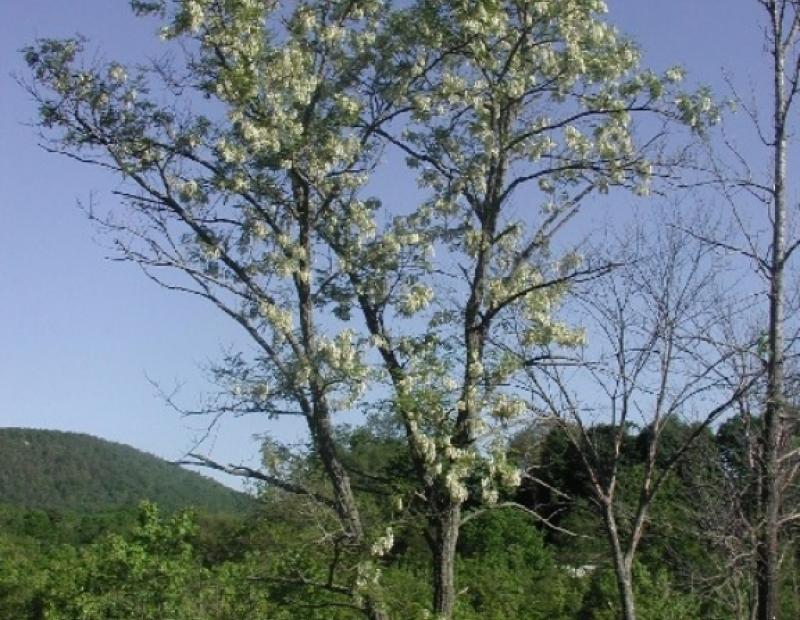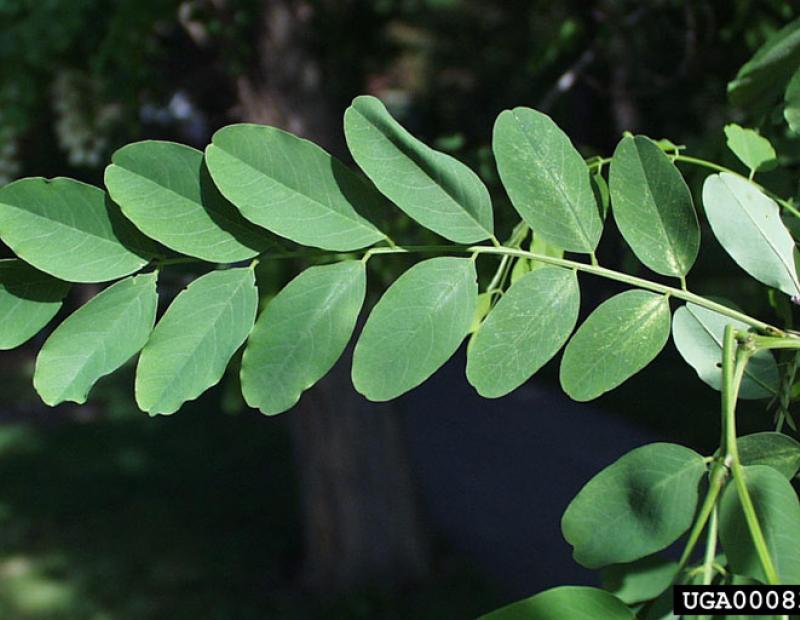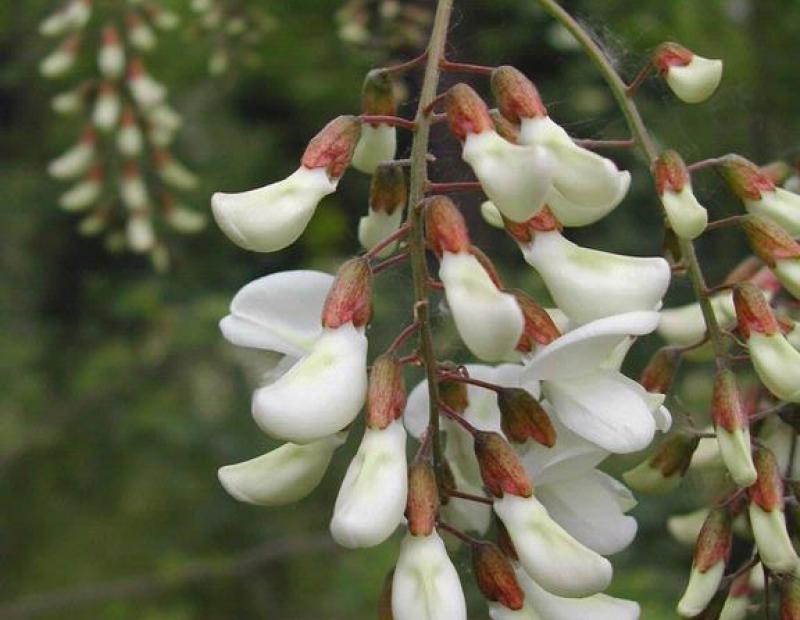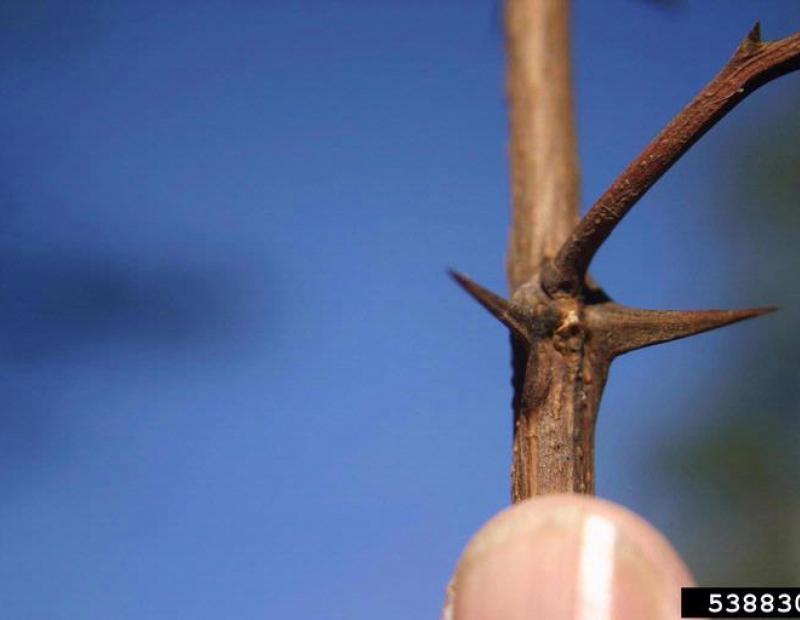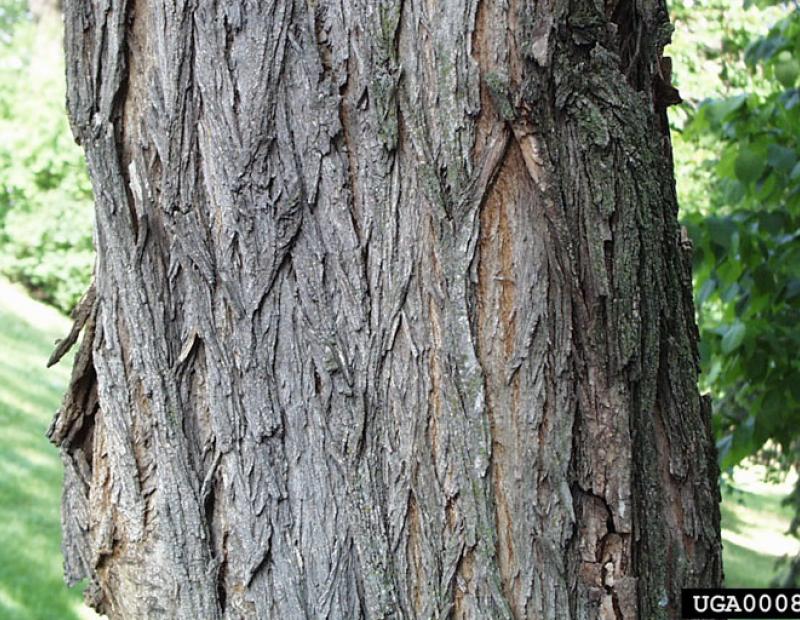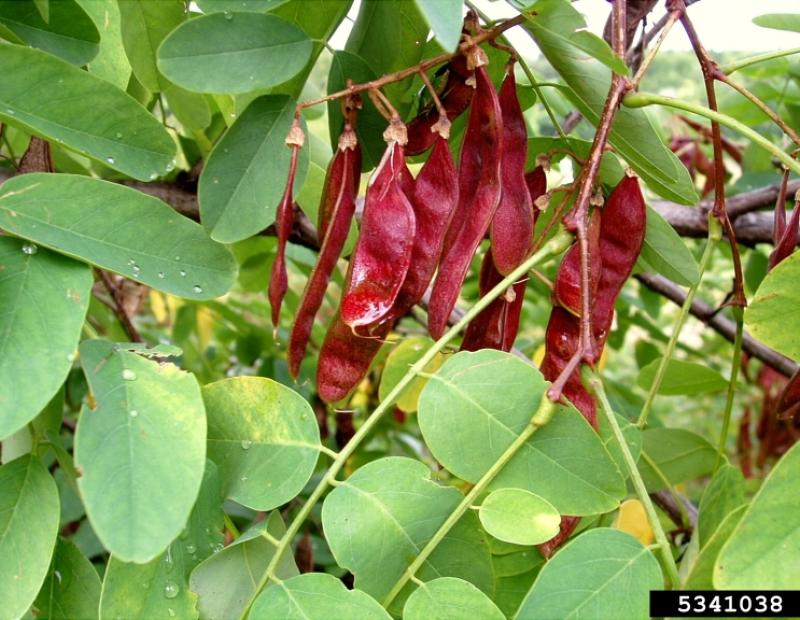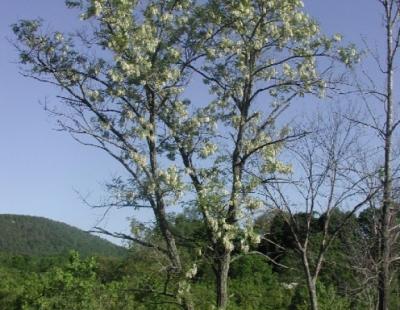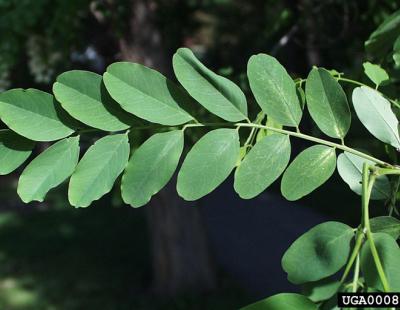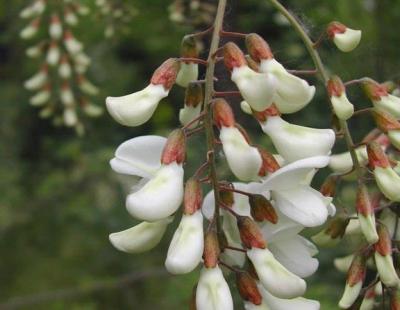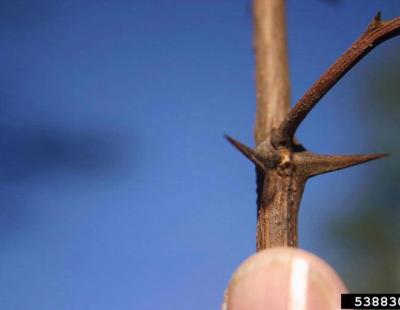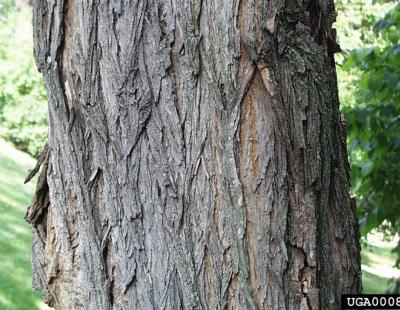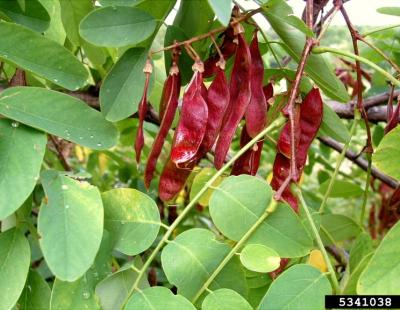Vertical Tabs
- Black locust is a member of the Legume family (Fabaceae)
- A tall, attractive, spring blooming tree, Black locust is most easily recognizable in late May and early June when abundant racemes of white to pinkish flowers cover the trees’ open, irregularly shaped crowns. Black locust’s bark is deeply grooved and furrowed. Trees have extremely sharp spines at the nodes of young branches and twigs. (4)
Leaves
Leaves are alternately arranged, compound and comprised of 7-19 leaflets on a leaf that is 8-12 inches long. Each leaflet is oval, alternately arranged, and dull dark green in color. (2)
Flowers
Flowers are white, fragrant, bilaterally symmetrical and arranged in showy, six inch long drooping clusters. (2)
Fruit/Seed
Flowers develop into elongate, flat brown pods 2-4 inches long, similar in appearance to other members of the bean family. Each pod contains 4-8 round, flat seeds brownish reddish in color. Often, fruits will hang on the tree well into winter, or even the following spring. (4)
Vegetative regeneration is vital in this plant's establishment, spread and persistence in non-native locations, giving it the ability to replace native vegetation. Developing black locust thickets can prevent other plants from establishing and may disrupt historical successional trajectories. In mixed-hardwood forests, these trees have been seen to contribute to elevated stream nitrate concentrations. Because of its nitrogen fixing abilities, black locust may also alter local soil characteristics, in turn disrupting biological activity in soil and preventing certain native plants from growing. Black locust canopies may block sunlight from reaching seedlings of other plants, such as native oaks, ultimately lowering species diversity. Seeds may remain viable in soil for more than 10 years, and are oportunistic in growth, giving them the ability to thrive through non-ideal conditions.
Biological Control
There is currently no single optimal biological control agent in use against this species, although a wide variety of native insects and fungi do target it. (4)
Manual or Mechanical Control
Pulling / Digging Up: Pulling by hand is an effective method of control for seedlings. For larger plants, disturbance of the root will encourage re-sprouting. (7)
Mowing: Not advisable. Black locust plants have a strong tendency to re-sprout following cutting or any kind of disturbance. If this strategy is pursued it must be undertaken consistently, several times a season, for several years. (8)
Girdling: Not advisable in isolation. Girdling alone encourages the formation of root suckers.
Prescribed Fire: Not advisable in isolation. Fire will kill the main stem of black locust trees but stimulate strong suckering and root sprouting. (7)
Prescribed Grazing: Not advisable. The high tannin content in leaves can interfere with ruminant digestion. (4)
Soil Tilling: Not advisable. Tilling will fragment roots and encourage re-sprouting. It will also expose more seeds for germination. (8)
Mulching: Not applicable
Solarization: Not applicable
Hot Foam Spray: Not applicable
Chemical Control
Foliar Spray: A 1% solution of glyphosate or triclopyr is effective at managing small plants of black locust, although repeat applications may be necessary. Infestations managed in this way should be revisited in 2-3 weeks to monitor for regrowth. Always read and follow all instructions on the herbicide label. (8)
Cut Stump: A 20-50% solution of glyphosate is effective at managing larger plants of black locust when applied to cut stumps in the late summer or fall. (8)
Basal Bark: A 20% solution of triclopyr in oil is effective on trees with thin bark (i.e less than 6 inches in diameter) when applied between midsummer and December.(8)
Hack-And-Squirt: No information available.
Stem Injection: A 10% solution of Aminopyralid can be used in stem injections during the late summer and fall.
Pre-Emergent Spray: Not applicable
The pesticide application rates and usage herein are recommendations based on research and interviews with land managers. When considering the use of pesticides, it is your responsibility to fully understand the laws, regulations and best practices required to apply pesticides in a responsible manner. At times, the pest you seek to treat may not be listed on a pesticide label, requiring a 2(ee) exemption from NYSDEC. Always thoroughly read the label of any pesticide and consult the NYSDEC or a licensed pesticide applicator with questions.
General management overview and recommendation
As with any other invasive infestation complex, large stands of black locust are best managed via a combination of mechanical and chemical means. Small seedlings can be hand pulled or sprayed while larger trees must be sprayed, either with a basal bark or cut stump application, to attain good control. All managed infestations should be monitored to ensure exhaustion of the seed bank and to prevent reinvasion from nearby populations. Any new seedlings can be hand pulled or sprayed.
Post treatment monitoring
Any infestations managed by chemical means must be revisited in 2-3 weeks to check for treatment efficacy. Infestations managed solely by mechanical or physical means will need consistent follow up treatment to manage root suckers and sprouts. Due to the species long-lived seed bank, managed infestations should be intentionally revegetated and monitored for future black locust seedling emergence.
Disposal Methods
Waste material can be burned, chipped or composted so long as management was completed prior to seed set. Any fruit must be bagged and disposed of. All roots must be thoroughly dried and or crushed.
REFERENCES
- https://www.dec.ny.gov/docs/lands_forests_pdf/isprohibitedplants2.pdf
- https://gobotany.newenglandwild.org/species/robinia/pseudoacacia/
- http://www.eddmaps.org/ipane/ipanespecies/trees/robinia_pseudoacacia.htm
- https://www.cabi.org/isc/datasheet/47698
- https://gobotany.newenglandwild.org/species/gleditsia/triacanthos/
- https://www.cabdirect.org/cabdirect/abstract/19460701760
- https://www.fs.fed.us/database/feis/plants/tree/robpse/all.html#BOTANICA...
- https://mdc.mo.gov/tree-plants/problem-plant-control/nuisance-native-pla...

